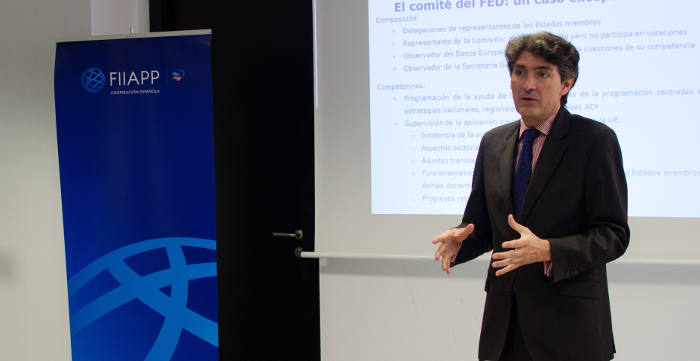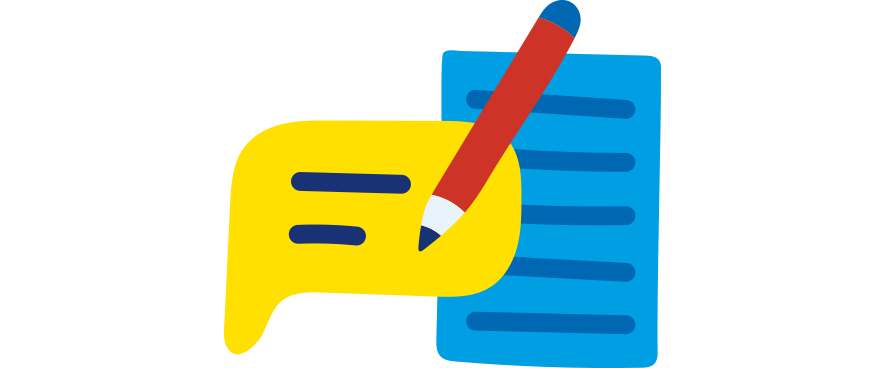-
14 April 2016
Category : Interview
“All the decisions taken by the European Commission must go before a committee”
Have you ever heard of commitology? The European Commission has a series of instruments for managing its external action. In addition, all of its decisions must go before a committee before being implemented. The European Union's Assistant Deputy for External Relations and Trade, Eduardo Romero, gives us some of the details about part of the European Commission's management and tells us what commitology is.
 Eduardo Romero talks about commitology in a monograph organised by FIIAPP.
Eduardo Romero talks about commitology in a monograph organised by FIIAPP.What is commitology?
Commitology is the European Union’s way of implementing its rules.
The processes for approving European rules are very complex, as the institutions with legislative capacity are, essentially, the Council and the European Parliament. As a result, when rules are approved, the Commission implements them, but always under the supervision of the competent committees.
All the decisions taken by the European Commission must go before a committee.
Which rules go before a committee?
The rule itself establishes when there is an implementing committee and when not. In 99% of cases, the rule establishes that there will be monitoring by a committee. This is its “implementing regulation” if we were speaking in terms of Spanish legislation.
Who are the people on these committees?
The committees are made up of one representative from each Member State, who can vote to give implementation of the proposal by the Commission a green light, and from the European Commission, which acts as the chair but does not vote.
How many different types of committees are there?
At the moment, there are two types of committees. The most frequent type is that which is responsible for the examination procedure, which addresses subjects regarding programmes with important implications. Such as, the Common Agricultural Policy (CAP), the Common Fisheries Policy; the environment; security; protection of health; the security of persons, animals and plants; or the Common Trade Policy and fiscal aspects.
The second type of committee is that of the consultation procedure, which is basically used for all other matters.
What situation has to exist for a rule to be approved?
In the examination procedure, the more habitual of the two, a rule is voted on, and approval requires a double majority, so 55% of the Member States, or 16 out of the 28, have to vote in favour. And this minimum of 16 States has to represent 65% of the total population. These figures are reviewed yearly as the population fluctuates.
How does the European Commission implement its external action?
To carry out its external action, which represents approximately 6% of the total EU budget, the Commission is equipped with different instruments, to which amounts of money are allocated according to the area, which can be geographic or thematic. These instruments include the Development Cooperation Instrument, the Neighbourhood Instrument, the Instrument for Pre-Accession Assistance, the fund corresponding to humanitarian aid, and the European Development Fund (EDF), which is a very special case.
What makes the European Development Fund so special?
The European Development Fund has been active for over 50 years and has its own regulations, which gradually have become more like other instruments. This is the largest instrument of the European Commission, as it has €30 billion for seven years (2014-2020), of which Spain contributes more than 24 billion, nearly 8%. It is unique in that it is the only fund that is not part of the community budget. In other words, the money allocated to all the other instruments comes from the EU budget, but not in this case.
The community budget is funded by series of objective elements, GDP, VAT, customs duties, etc. In the case of the EDF, each Member State decides how much money to contribute. Spain is currently the fifth-largest contributor.
Who is on the EDF committee?
The EDF committee is made up of representatives of the Member States; one non-voting representative of the Commission, who acts as the chair; one observer from the European Investment Bank (EIB), which is one of the most important implementing bodies of the EDF; and officials from the European External Action Service (EEAS).
What does the EDF committee approve?
In this committee, the rules that are approved are projects or programmes that are going to be funded by the EDF.
For votes in this type of committee, the amount of money contributed by each Member State is taken into account: Therefore Spain has 79 votes because it contributes 7.9%.
In the case of the EDF, 721 votes are necessary to approve a project, but the vast majority of projects are approved by consensus.
How is Spain represented on the EDF committee?
Spain’s representation on the EDF committee corresponds to the Ministry of Economy and Competitiveness (MINECO), because it is an extra-budgetary fund that is financed, in Spain’s case, directly through contributions from the Treasury (MINHAP).
How often does the EDF committee meet?
More or less once a month. It varies depending on the projects that reach the committee.
The views and opinions expressed in this blog are the sole responsibility of the person who write them.






